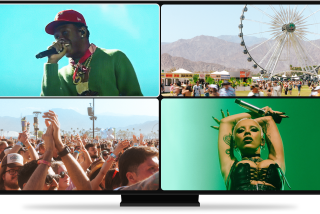YouTube in talks with big studios
The most popular site for watching video on the Internet may soon get Hollywood’s most popular movies.
Google Inc.’s YouTube is in talks with several major studios -- including Sony Pictures, Warner Bros. and Lionsgate -- about streaming movies when the DVDs become available in rental stores and kiosks, according to sources familiar with the situation.
The move represents a bold gambit for the entertainment giants, which have been cautious in embracing the Internet out of fear it would disrupt relationships with major retailers and undercut lucrative DVD sales.
But with DVD sales in a cliff dive and the growing popularity of websites such as Hulu, where TV shows and second-tier movies are available to watch free of charge, Hollywood finally appears to be embracing the notion that the Internet could become a major venue for movie distribution.
Movie theater attendance isn’t growing, and the studios are finding it tougher to attract paying audiences that are large enough to justify the huge expense of producing and marketing their films, which increasingly are forced to compete against video games and other forms of entertainment.
Despite YouTube’s dominance in Internet video, several companies already offer online movie rentals and downloads, including Amazon.com Inc. and Apple Inc. The fast-growing DVDs-by-mail service Netflix also streams films online. But with 437 million visitors a month, YouTube is the gorilla in the Internet video market, and any studio that aligns with it will be in an advantaged position against rivals. This means Google might finally be able to make YouTube profitable. And for the studios, it might be a way to win back the lost revenue from declining DVD sales.
YouTube has been in discussions with studio executives for several months, exploring options, said people with knowledge of the matter, which was first reported by the Wall Street Journal. The website initially proposed an advertising-supported model in which the movies would be offered to online viewers free of charge. Hollywood pushed for a more traditional pay model, however, in which films would be available to buy as a download or a $3.99 rental.
YouTube has had a contentious history with Hollywood, beginning with its roots as a repository for illicitly copied television and movie content. It pinged the entertainment industry’s radar in 2005 when “Lazy Sunday,” a short “Saturday Night Live” clip, was posted on the site and racked up millions of views before being removed.
Partly on the back of copyrighted material -- comedy shows, sports and movie clips -- the video-hosting site grew wildly popular. But that popularity was anathema to an angry Hollywood, which viewed YouTube as turning a blind eye to piracy.
“With a combination of ignorance, naivete and arrogance, they set off the immune system of the entire industry,” said Jeffrey Lindsay, an analyst at Sanford C. Bernstein & Co., who said the young site was making enemies when it should have been making allies. “They missed a golden opportunity to get the industry on their side,” he said.
The enmity came to a head in 2007 when media giant Viacom initiated a $1-billion lawsuit against YouTube over copyright concerns, saying the site was “brazenly exploiting” its position to make money off of the hard work of the entertainment industry. The suit is ongoing.
But since that time, YouTube has sought to clean up its act.
In an effort to become less like a rowdy digital saloon and more like a quiet online movie theater, the site is hoping to woo Hollywood back, premium content in tow. To create a welcoming environment, YouTube has tightened rules about language and racy content and has built special screening areas -- such as its “Shows” section -- that safely house its growing library of studio-produced movies and television.
As a result, Hollywood appears to be gradually overcoming its fear of the Google boogeyman.
Sony Pictures began to experiment this spring with offering older full-length movies and television shows, including “Spider-Man” and “News Radio.” The shows were free and supported by advertising. In August, YouTube hosted a full-length version of Sony’s 1984 film “Ghostbusters,” which attracted about 680,000 viewers in a week. YouTube has pointed to the screening as illustrating the site’s power as a major outlet for mainstream content.
Disney/ABC Television Group began putting clips on YouTube this spring: video highlights and interviews with the stars of its most popular prime-time shows, including “Desperate Housewives,” “Lost” and “Grey’s Anatomy,” as well as sports highlights from its cable sports network, ESPN. Time Warner Inc. this month started offering video clips from its CNN news coverage and its Cartoon Network and Warner Bros. Television shows, such as “Gossip Girl.”
YouTube has been courting more professionally produced content, in part to attract advertisers who are reluctant to place their brands next to amateur videos of karaoke and wedding pratfalls. But the Internet ad business has been in a tailspin for more than a year. Online ad revenue shrank during the second quarter to $13.9 billion from $14.7 billion, down 5% from a year earlier, according to technology consulting firm IDC. And the worst isn’t over: IDC expects it to continue hemorrhaging for at least the rest of the year.
Offering movie rentals would provide a fresh source of revenue for YouTube -- and push the site closer to something that, despite an audience that sometimes even dwarfs the viewership of network TV shows, has eluded it: profitability.
--
dawn.chmielewski@ latimes.com
Times staff writer Joe Flint contributed to this report.
More to Read
The biggest entertainment stories
Get our big stories about Hollywood, film, television, music, arts, culture and more right in your inbox as soon as they publish.
You may occasionally receive promotional content from the Los Angeles Times.










